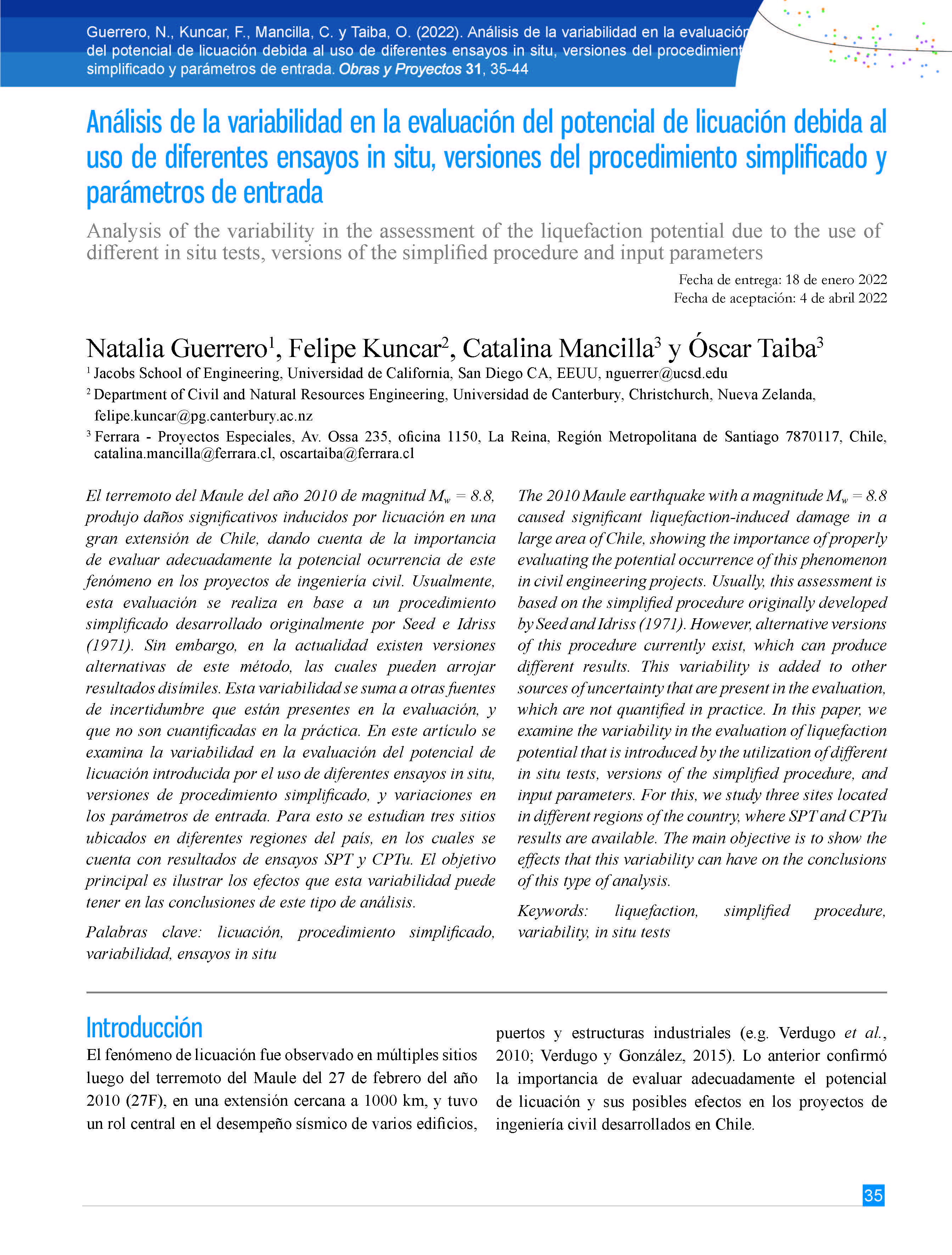Análisis de la variabilidad en la evaluación del potencial de licuación debida al uso de diferentes ensayos in situ, versiones del procedimiento simplificado y parámetros de entrada
DOI:
https://doi.org/10.4067/s0718-28132022000100035Palabras clave:
Licuación, Procedimiento simplificado, Variabilidad, Ensayos in situResumen
El terremoto del Maule del año 2010 de magnitud Mw = 8.8, produjo daños significativos inducidos por licuación en una gran extensión de Chile, dando cuenta de la importancia de evaluar adecuadamente la potencial ocurrencia de este fenómeno en los proyectos de ingeniería civil. Usualmente, esta evaluación se realiza en base a un procedimiento simplificado desarrollado originalmente por Seed e Idriss (1971). Sin embargo, en la actualidad existen versiones alternativas de este método, las cuales pueden arrojar resultados disímiles. Esta variabilidad se suma a otras fuentes de incertidumbre que están presentes en la evaluación, y que no son cuantificadas en la práctica. En este artículo se examina la variabilidad en la evaluación del potencial de licuación introducida por el uso de diferentes ensayos in situ, versiones de procedimiento simplificado, y variaciones en los parámetros de entrada. Para esto se estudian tres sitios ubicados en diferentes regiones del país, en los cuales se cuenta con resultados de ensayos SPT y CPTu. El objetivo principal es ilustrar los efectos que esta variabilidad puede tener en las conclusiones de este tipo de análisis.
Referencias
Boulanger, R.W. and Idriss, I.M. (2014). CPT and SPT based liquefaction triggering procedures. Report UCD/CGM-14/01, Department of Civil and Environmental Engineering, University of California, Davis CA, USA.
Bray, J.D. and Sancio, R.B. (2006). Assessment of the liquefaction susceptibility of fine-grained soils. Journal of Geotechnical and Geoenviromental Engineering 132(9), 1165-1177.
DS61 (2011). Reglamento que fija el diseño sísmico de edificios. Decreto Supremo ds61. Ministerio de Vivienda y Urbanismo, Santiago, Chile.
Idriss, I.M. and Boulanger, R.W. (2004). Semi-empirical procedures for evaluating liquefaction potential during earthquakes. 11th International Conference on Soil Dynamics & Earthquake Engineering ICSDEE and 3rd International Conference on Earthquake Geotechnical Engineering ICEGE, D. Doolin et al. (eds.), University of California, Berkeley CA, USA, vol. 1, 32-56.
Idriss, I.M. and Boulanger, R.W. (2008). Soil liquefaction during earthquakes. Earthquake Engineering Research institute, Oakland CA, USA.
Kramer, S.L. (1996). Geotechnical earthquake engineering. Prentice Hall, Upper Saddle River NJ, USA.
Marchetti, S., Marchetti, D. y Villalobos, F. (2013). El dilatómetro sísmico SDMT para ensayos de suelos in situ. Obras y Proyectos 13, 20-29.
NCh3364 (2014). Geotecnia - Ensayo de Penetración Estándar. Instituto Nacional de Normalización INN, Santiago, Chile.
Robertson, P.K. and Wride, C.E. (1998). Evaluating cyclic liquefaction potential using the cone penetration test. Canadian Geotechnical Journal 35(3), 442-459.
Seed, H.B. and Idriss, I.M. (1971). Simplified procedure for evaluating soil liquefaction potential. Journal of the Soil Mechanics and Foundation Division 97(9), 1249-1273.
Verdugo, R. and González, J. (2015). Liquefaction-induced ground damages during the 2010 Chile earthquake. Soil Dynamics and Earthquake Engineering 79, 280-295.
Verdugo, R., Villalobos, F., Yasuda, S., Konagai, K., Sugano, T., Okamura, M., Tobita, T. and Torres, A. (2010). Description and analysis of geotechnical aspects associated to the large 2010 Chile earthquake. Obras y Proyectos 8, 25-36.
Youd, T.L. and Idriss, I.M. (2001). Liquefaction resistance of soils: summary report from the 1996 NCEER and 1998 NCEER/ NSF workshops on evaluation of liquefaction resistance of soils. Journal of Geotechnical and Geoenviromental Engineering 127(4), 297-313.

Descargas
Publicado
Número
Sección
Licencia

Esta obra está bajo una licencia internacional Creative Commons Atribución-NoComercial 4.0.







